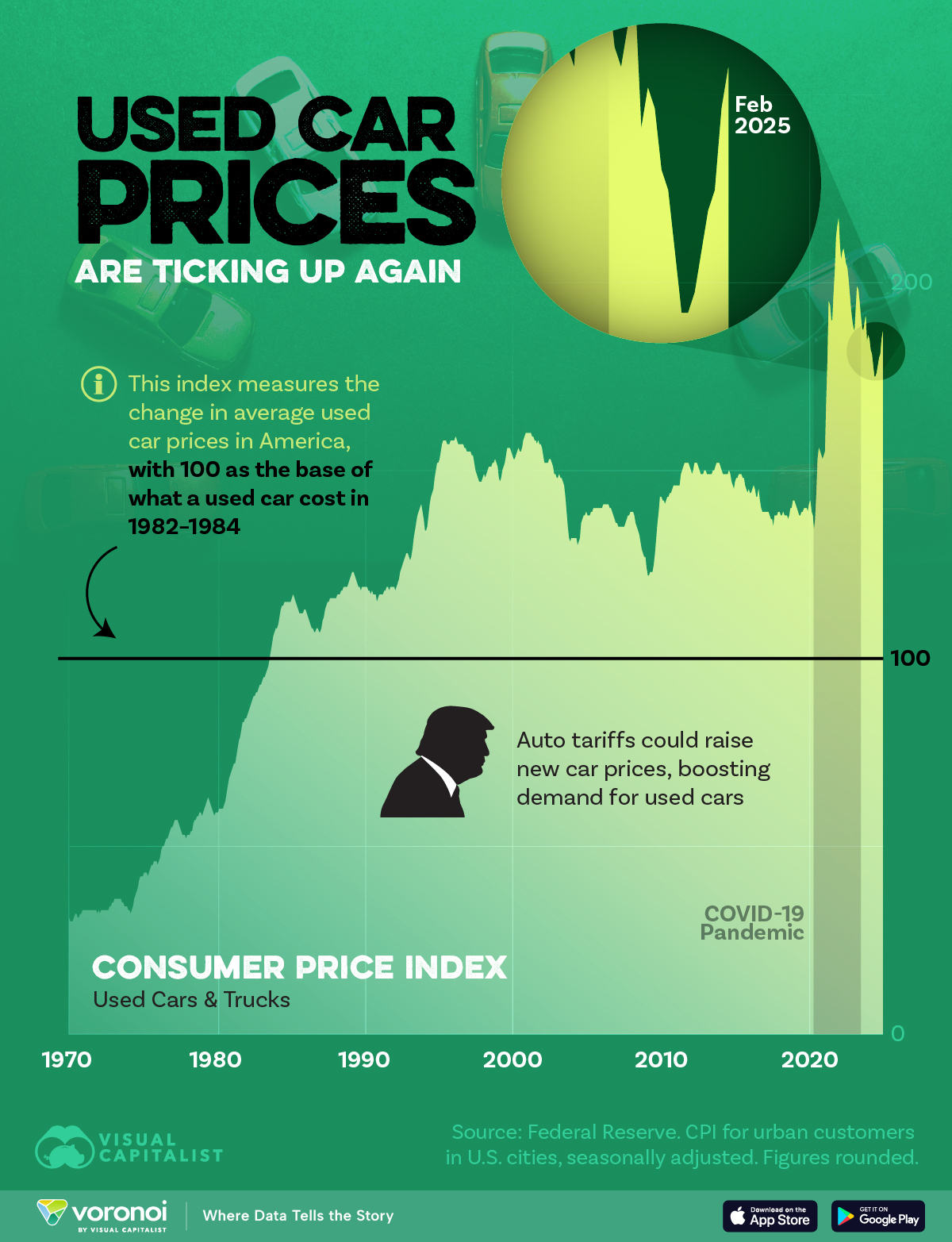Used Car Prices Are Climbing—Will Tariffs Push Them Higher?
This was originally posted on our Voronoi app. Download the app for free on iOS or Android and discover incredible data-driven charts from a variety of trusted sources.
The long build up to auto tariffs has ended with 25% additional fees on imported cars that don’t comply with USMCA trade rules going into effect on April 3rd.
What does this mean? As this CNN article explains, a $40,000 imported new car (not assembled in the U.S.) will attract $10,000 in tariff dues.
“Let’s be real honest: Long term, a 25% tariff across the Mexico and Canada borders would blow a hole in the US industry that we’ve never seen.” — Jim Farley, Ford CEO, February, 2025.
If automakers choose to pass on these costs, the customer will end up paying $50,000 for the same car.
S&P Global Mobility estimates that nearly half of the 16 million new cars purchased in 2024 were imported. Experts say that new car prices can go up anywhere between $4,000–$12,000, depending on the extent they comply with USMCA exemptions.
 Auto tariffs are placed separately and will not combine with blanket trade tariffs also announced on April 2nd.
Auto tariffs are placed separately and will not combine with blanket trade tariffs also announced on April 2nd.This means American customers might look to the used car market for their big purchase.
Unfortunately, used car prices never fully came down from their pandemic highs. We use consumer price index data from the Federal Reserve to reveal the price trends in the used car and truck market.
Used Car and Truck Pricing Trends Since 1970
The Federal Reserve measures price changes by using an indexing method. The average price of a used car or truck between 1982–1984 is set to a value of 100.
This means that when index scores crossed 200 in the pandemic, prices had essentially doubled from 1982–84.
| Year / Month | CPI (Used Cars & Trucks) |
|---|---|
| 2019-01-01 | 142 |
| 2019-02-01 | 142 |
| 2019-03-01 | 141 |
| 2019-04-01 | 140 |
| 2019-05-01 | 139 |
| 2019-06-01 | 138 |
| 2019-07-01 | 138 |
| 2019-08-01 | 139 |
| 2019-09-01 | 139 |
| 2019-10-01 | 140 |
| 2019-11-01 | 140 |
| 2019-12-01 | 140 |
| 2020-01-01 | 139 |
| 2020-02-01 | 141 |
| 2020-03-01 | 142 |
| 2020-04-01 | 139 |
| 2020-05-01 | 138 |
| 2020-06-01 | 134 |
| 2020-07-01 | 137 |
| 2020-08-01 | 144 |
| 2020-09-01 | 153 |
| 2020-10-01 | 156 |
| 2020-11-01 | 155 |
| 2020-12-01 | 154 |
| 2021-01-01 | 153 |
| 2021-02-01 | 154 |
| 2021-03-01 | 155 |
| 2021-04-01 | 168 |
| 2021-05-01 | 179 |
| 2021-06-01 | 195 |
| 2021-07-01 | 194 |
| 2021-08-01 | 190 |
| 2021-09-01 | 190 |
| 2021-10-01 | 197 |
| 2021-11-01 | 203 |
| 2021-12-01 | 212 |
| 2022-01-01 | 215 |
| 2022-02-01 | 217 |
| 2022-03-01 | 210 |
| 2022-04-01 | 206 |
| 2022-05-01 | 208 |
| 2022-06-01 | 209 |
| 2022-07-01 | 207 |
| 2022-08-01 | 205 |
| 2022-09-01 | 204 |
| 2022-10-01 | 201 |
| 2022-11-01 | 197 |
| 2022-12-01 | 193 |
| 2023-01-01 | 190 |
| 2023-02-01 | 188 |
| 2023-03-01 | 187 |
| 2023-04-01 | 193 |
| 2023-05-01 | 199 |
| 2023-06-01 | 198 |
| 2023-07-01 | 195 |
| 2023-08-01 | 191 |
| 2023-09-01 | 188 |
| 2023-10-01 | 187 |
| 2023-11-01 | 189 |
| 2023-12-01 | 191 |
| 2024-01-01 | 184 |
| 2024-02-01 | 186 |
| 2024-03-01 | 185 |
| 2024-04-01 | 182 |
| 2024-05-01 | 181 |
| 2024-06-01 | 178 |
| 2024-07-01 | 175 |
| 2024-08-01 | 175 |
| 2024-09-01 | 176 |
| 2024-10-01 | 178 |
| 2024-11-01 | 180 |
| 2024-12-01 | 181 |
| 2025-01-01 | 185 |
| 2025-02-01 | 187 |
Note: Measures average price changes for urban customers only. Figures rounded.
After peaking in February 2022, used car prices began a slow decline.
However, since August 2024 they’ve climbed for six straight months.
And if automakers pass on tariff costs, and new cars become more expensive, then the used car market is likely to heat up again.
So, Which Automakers Will Pass on Tariffs?
Responses from car manufacturers have diverged. Ford is offering “employee pricing” for the next two months, essentially lowering prices for its existing inventory.
Of the Big Three automakers, Ford is best positioned to weather the storm. Nearly 80% of its inventory is assembled in America. Stellantis is at 57% and GM at about 50%.
For reference, Tesla assembles all of its American inventory within the country.
On the other end of reactions, Volkswagen is warning dealers that import tariffs will be added to their costs. How dealers choose to pass this on—or absorb them—is still unclear.
Finally, a tariff on auto parts is expected next month. Even the most American-made cars (Tesla, Ford) have a significant number of foreign-made auto parts. This could also lead to price increases.
Learn More on the Voronoi App 
Wondering which car or truck models will be most affected? Check out: Every Car Made in Canada for a bird’s eye view of the companies with Canadian supply chains.
The post Used Car Prices Are Climbing—Will Auto Tariffs Push Them Higher? appeared first on Visual Capitalist.

